Lewin Benjamin (ed.) Genes IX
Подождите немного. Документ загружается.

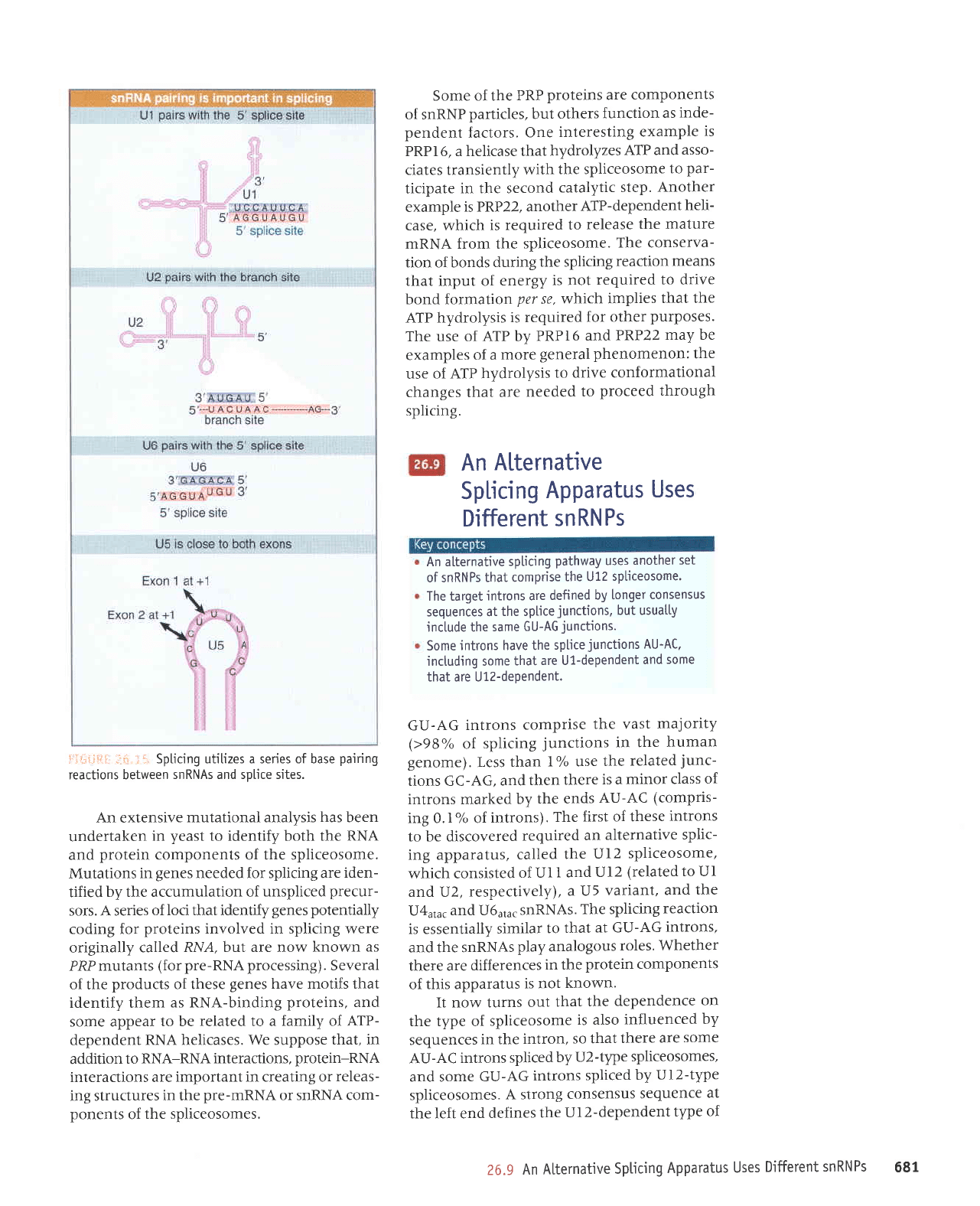
Some of the
PRP
proteins
are
components
of snRNP
particles,
but
others
function
as
inde-
pendent
factors.
One
interesting
example
is
PRPl6, a helicase that
hydrolyzes
ATP and
asso-
ciates transiently
with
the spliceosome
to
par-
ticipate
in the second
catalytic
step.
Another
example
is PRP22, another
ATP-dependent
heli-
case, which
is required
to
release
the mature
mRNA from the
spliceosome.
The conserva-
tion of bonds
during
the splicing
reaction
means
that input of
energy
is not
required
to drive
bond formation
per
se,
which implies
that the
ATP
hydrolysis
is required
for
other
purposes.
The use of
ATP by
PRPI6
and
PRP22
may be
examples
of a
more
general
phenomenon: the
use
of ATP hydrolysis
to drive
conformational
changes that
are
needed
to
proceed through
splicing.
:i,,"Lit.r-
ilii,=;
*
Spl.icing utitizes a series of base
pairing
reactions between
snRNAs and splice sites.
An extensive
mutational analysis
has
been
undertaken
in
yeast
to identify both the RNA
and
protein
components of the spliceosome.
Mutations
in
genes
needed for splicing are
iden-
tified
by the accumulation of
unspliced
precur-
sors. A series
of loci that identify
genes potentially
coding for
proteins
involved in splicing were
originally
called
RNA, but are now known
as
PRP mutants
(for pre-RNA processing).
Several
of the
products
of these
genes
have motifs that
identily them
as RNA-binding
proteins,
and
some appear
to be
related
to a
family of ATP-
dependent
RNA helicases. We suppose
that, in
addition
to RNA-RNA
interactions,
protein-RNA
interactions are
important in creating or
releas-
ing structures
in the
pre-mRNA
or snRNA com-
ponents
of
the spliceosomes.
An
Alternative
SpLicing
Apparatus
Uses
Different
snRNPs
An alternative
splicing
pathway
uses
another
set
of snRNPs
that comprise
the U12
sp[iceosome'
The target
introns are
defined
by longer
consensus
sequences at
the sptice
junctions,
but usuatly
inctude the
same
GU-AG
junctions.
Some
introns have the
splice
junctions
AU-AC.
including some
that
are U1-dependent
and
some
that are U12-dependent.
GU-AG
introns
comprise
the vast
majority
(>98%
of
splicing
junctions
in the
human
genome).
Less
than
17o use
the
related
junc-
tions GC-AG,
and
then
there
is a
minor class
of
introns marked
by
the ends
AU-AC
(compris-
ing 0.17o of
introns).
The
first of these
introns
to be discovered
required
an
alternative
splic-
ing apparatus,
called
the
UI2
spliceosome,
which consisted
of Ul1
and
Ul2
(related
to Ul
and U2,
respectively),
a U5
variant,
and
the
U4uru.
and U6u,u.
snRNAs.
The splicing
reaction
is essentially
similar
to
that
at GU-AG
introns,
and the snRNAs
play
analogous
roles. Whether
there are
differences
in the
protein components
of
this apparatus
is not
known.
It now turns
out
that
the
dependence
on
the type of
spliceosome
is also
influenced
by
sequences
in the
intron,
so that
there
are
some
AU-AC
introns
spliced
by
U2-t1pe
spliceosomes,
and some
GU-AG
introns
spliced
by
Ul2-type
spliceosomes.
A strong
consensus
sequence
at
the left end
defines
the
Ul2-dependent
type
of
26.9
An
Alternative
Spticing
Apparatus
Uses
Different
snRNPs
681
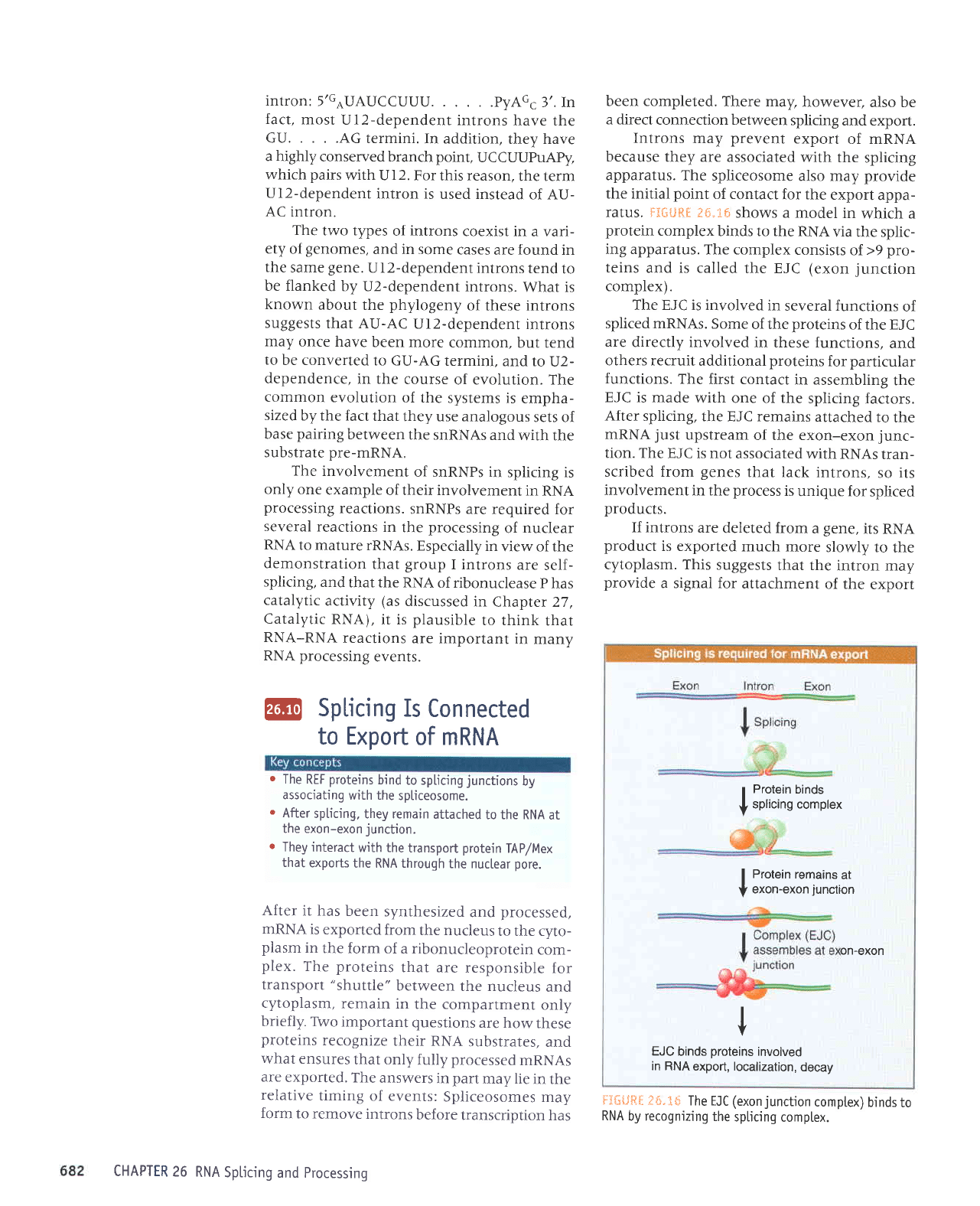
intron:
5'GAUAUCCUUU.
.
.pyAG6
3'. In
fact,
most
Ul2-dependent
introns
have the
GU. . . .AG
termini.
In addition,
they have
a highly
conserved branch point,
UCCUUPuAPy,
which
pairs
with
U
I 2.
For
this reason,
the term
Ul2-dependent
intron is
used instead
of AU-
AC intron.
The
two types
of introns
coexist in
a vari-
ety
of
genomes,
and in some
cases
are
found
in
the
same
gene.
UI2-dependent
introns
tend
to
be flanked
by
U2-dependent
inrrons.
What is
known
about the
phylogeny
of these introns
suggests
that AU-AC
Ul2-dependent
introns
may
once have
been more
common,
but tend
ro
be converted
to GU-AG
termini,
and to
U2-
dependence,
in the
course
of evolution. The
common
evolution
of the
systems is
empha-
sized
by the fact
that
they use analogous
sets of
base
pairing
between
the snRNAs
and
with the
substrate
pre-nRNA.
The
involvement
of snRNPs in
splicing is
only
one
example
of their involvement
in
RNA
processing
reactions.
snRNPs are
required for
several
reactions
in
the
processing
of
nuclear
RNA to
mature rRNAs.
Especially
in
view of the
demonstration
that
group
I introns
are
self-
splicing,
and
that the RNA
of ribonuclease
P
has
catalytic
activity
(as
discussed
in
Chapter 27,
Catalytic
RNA),
it is
plausible
to think
that
RNA-RNA
reactions
are important
in
many
RNA
processing
events.
@
Splicing
Is
Connected
to Export
of
mRNA
r
The
REF
proteins
bind
to splicing
junctions
by
associating
with the
sp[iceosome.
.
After
spticing,
they remain
attached
to the RNA
at
the exon-exon
junction.
o
They
interact
with the
transport
protein
TAP/Mex
that
exports
the RNA through
the nuctear
pore.
After
it has
been
synthesized
and
processed,
nRNA is
exported
from
the nucleus
to the cyto-
plasm
in
the form
of a ribonucleoprotein
com-
plex.
The proteins
that are
responsible
for
transport
"shuttle"
between
the nucleus
and
cytoplasm,
remain
in
the compartment
only
briefly. TWo
important questions
are how
these
proteins
recognize
their RNA
substrates,
and
what ensures
that only
fully
processed
mRNAs
are
exported.
The
answers
in
part
may lie
in the
relative
timing
of events:
Spliceosomes
may
form
to remove
introns
before
transcription
has
CHAPTER
26
RNA
SpLicing
and Processing
been completed.
There may,
however,
also be
a direct
connection between
splicing
and export.
Introns
may
prevent
export
of mRNA
because
they are
associated
with the
splicing
apparatus. The
spliceosome
also may
provide
the initial
point
of contact
for the
export
appa-
ratus. FIGURE
t6-ie
shows a
model in
which a
protein
complex
binds to the
RNA
via the splic-
ing apparatus.
The complex
consists
of
>9 pro-
teins
and is called
the EJC
(exon
junction
complex).
The EJC is involved
in
several functions
of
splicedmRNAs.
Some
of the
proteins
of the
EJC
are
directly involved
in these
functions,
and
others recruit
additional
proteins
for
particular
functions.
The
first contact
in assembling
the
EJC is
made
with one of the
splicing
factors.
After
splicing,
the EJC remains
attached
to
the
mRNA
just
upstream
of the exon-exon
junc-
tion. The
EJC is not
associated
with RNAs
tran-
scribed from
genes
that lack
introns,
so
its
involvement
in the
process
is
unique for
spliced
products.
If introns
are
deleted from
a
gene,
its RNA
product
is exported
much
more
slowly to
the
cytoplasm. This
suggests
that the
intron may
provide
a signal for
attachment
of the
export
;
Protein
binds
I
splicing complex
I
Protein
remains
at
V
exon-exon
junction
on-exon
I
V
EJC
binds
proteins
involved
in RNA
export, localization,
decay
Fn$[.sftf
fS.ld
The EJC (exonjunction
comptex)
binds
to
RNA
by recognizing
the
spticing
comp[ex.
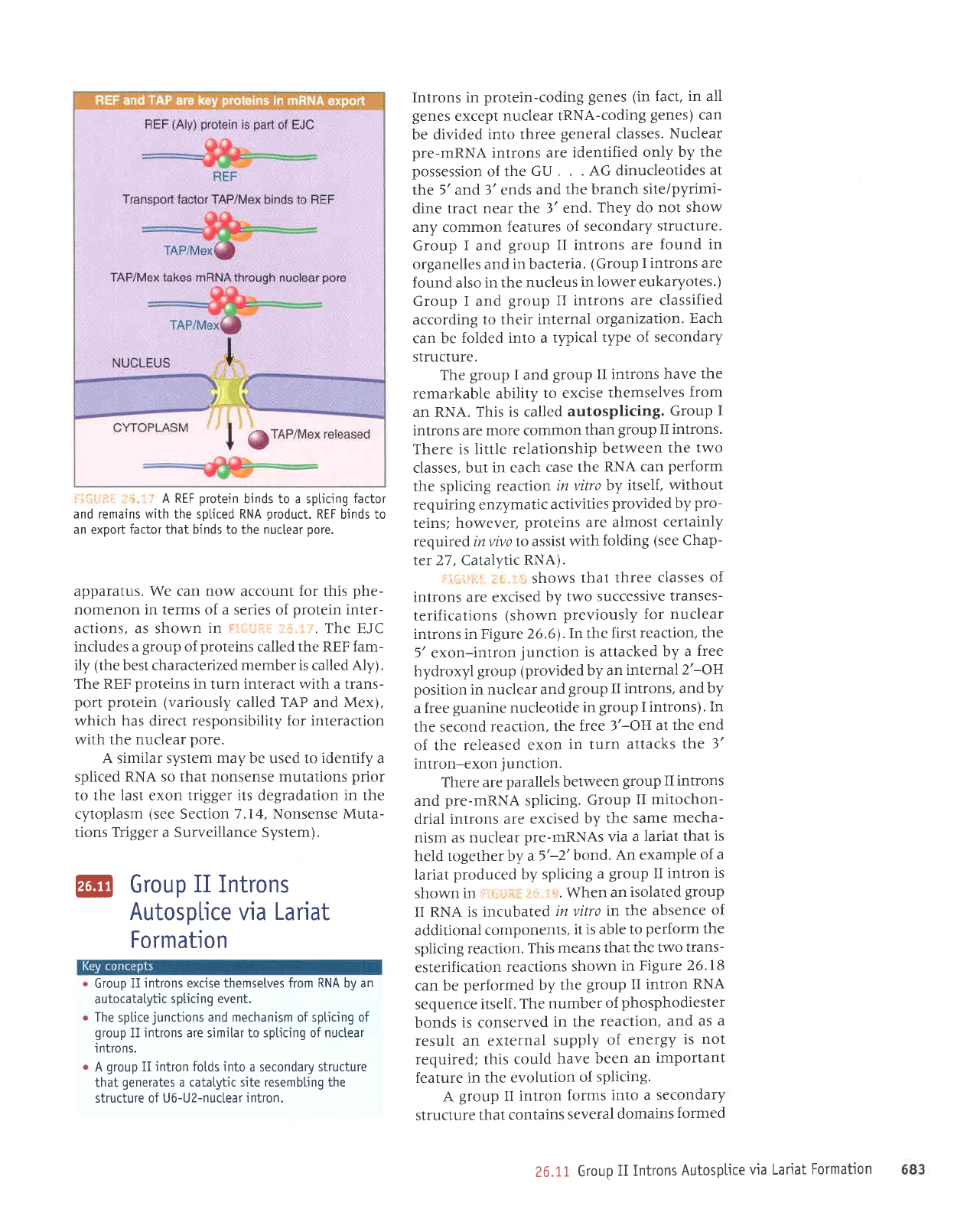
rl.l-;:ili;
,:i 1:
A REF
protein
binds to a splicing
factor
and
remains with
the spticed RNA
product.
REF binds to
an export
factor that
bjnds to the
nuctear
pore.
apparatus. We can now account for this
phe-
nomenon in terms of a series
of
protein
inter-
actions, as shown
in
iii;:iiii.,i1,.:,'.
The EJC
includes a
group
of
proteins
called the REF fam-
ily
(the
best characterized
member
is called
Aly).
The REF
proteins
in turn interact
with
a trans-
port protein (variously
called
TAP
and
Mex),
which
has
direct
responsibility
for interaction
with the nuclear
pore.
A similar system
may
be used to
identify
a
spliced
RNA so that nonsense mutations
prior
to the
last
exon trigger
its
degradation
in
the
cytoplasm
(see
Section
7.14,
Nonsense
Muta-
tions Trigger a Surveillance System).
Introns in
protein-coding
genes
(in
fact,
in
all
genes
except
nuclear IRNA-coding
genes)
can
be divided
into three
general classes. Nuclear
pre-nRNA
introns are
identified
only by the
possession
of the
GU .
. . AG dinucleotides
at
the 5' and 3' ends and
the branch
site/pyrimi-
dine tract
near the 3'
end.
They do not show
any common features
of secondary
structure.
Group I and
group II introns
are found
in
organelles
and in bacteria.
(Group
I introns are
found also
in the nucleus
in
lower eukaryotes.)
Group I and
group II introns
are classified
according to their
internal
organization.
Each
can be
folded into a typical
type of secondary
structure.
The
group I
and
group
II introns
have
the
remarkable
ability
to excise
themselves
from
an RNA. This
is called
autosplicing.
Group
I
introns are more common
than
group
II introns.
There is little
relationship
between
the two
classes. but
in each
case the
RNA
can
perform
the splicing
reaction
in vitro
by itself,
without
requiring enzymatic
activities
provided by
pro-
teins; however,
proteins are almost
certainly
required invivo ro assist
with
folding
(see
Chap-
ter 27, Catalytic
RNA).
r:ir,r.;
riir
'I
irr 5[6*t
that three
classes
of
introns
are
excised
by two
successive
transes-
terifications
(shown previously
for nuclear
introns in Figure
26.61.It
the
first reaction,
the
5' exon-intron
junction
is attacked
by a
free
hydroxyl
group
(provided by an
internal
2'-OH
position
in nuclear and
group
II
introns, and
by
a free
guanine
nucleotide
in
group I introns).
In
the second
reaction,
the
free
l'-OH at
the end
of the
released exon
in turn attacks
the 3'
intron-exon
junction.
There are
parallels
between
group II introns
and
pre-mRNA
splicing.
Group
II mitochon-
drial introns
are excised
by
the same
mecha-
nism as nuclear
pre-mRNAs via
a
lariat that
is
held togetherby
a
5'-2'bond.
An example
of a
lariat
produced by splicing
a
group II intron
is
shown in
i ::,r1r,,
,'ir.. i
i.
When
an
isolated
group
II RNA is incubated
in vitro
in the
absence
of
additional
components,
it is able
to
perform
the
splicing
reaction.
This means
that
the two
trans-
esterification
reactions
shown
in Figure
26.18
can
be
performed
by
the
group II intron
RNA
sequence
itself
. The
number
of
phosphodiester
bonds
is
conserved
in the
reaction,
and as
a
result an
external
supply
of
energy
is
not
required; this
could
have
been
an important
feature in the
evolution
of
splicing.
A
group
II intron
forms
into a secondary
structure
that contains
several
domains
formed
@
Group
II
Introns
Autosplice
via
Lariat
Formation
Group
II introns excjse themsetves from RNA by an
autocatatytic
splicing event.
The
splice
junctions
and mechanism
of spLicing
of
group
II introns are sjmitar to spLicing of nuctear
i ntro ns.
A
group
II intron folds into
a secondary
structure
that
generates
a catatytic site resembting the
structure of U6-U2-nuctear
intron.
26.11
Group
Ii Introns
Autosptice
via Lariat
Formation
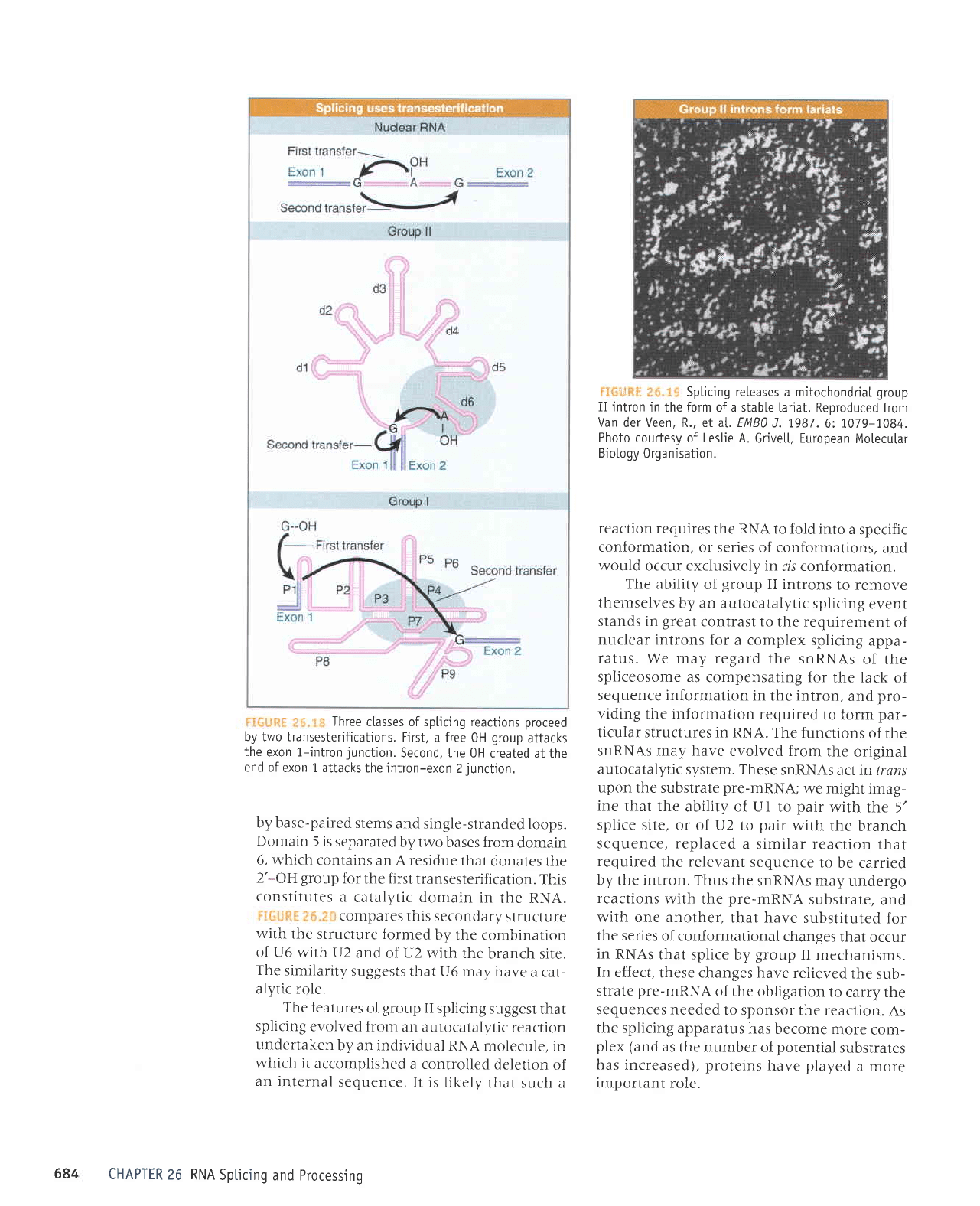
Three
c[asses of spticing reactions
proceed
by two transesterifications.
First,
a free
0H
group
attacks
the
exon 1-intron
junction.
Second, the
0H created at the
end of
exon 1 attacks
the intron-exon
2
iunction.
by base-paired
stems
and single-stranded
loops.
Domain
5
is
separated
by twct
bases from
domain
6, which
contains
an A residue
that
donates the
2'-OEgroup
lor
the first transesterification.
This
constitutes
a
catalytic domain
in
the RNA.
compares
this secondary
structure
with the
structure
formed
by the
cclmbinarion
of U6
with U2
and of U2
with the
branch site.
The
similarity
suggests
that
U6 may have
a cat-
alytic role.
The
features
of
group
II
splicing
suggest
that
splicing
evcllved from
an autocatalytic
reacrion
undertaken
by an individual
RNA
molecule,
in
which
it accomplished
a controlled
deletion
of
an internal
sequence.
It is likely
that such a
',
Splicing reteases
a mitochondrial
group
iI intron
in the form
of a stable [ariat. Reproduced
from
Van
der Veen, R., et aL. EMB]
J. 1,987.
6:
L079-1,084.
Photo
courtesy of Leslie A.
Grivelt, European
Molecular
Biol.ogy
0rga
nisation.
reaction
requires
the
RNA
to fold into
a
specific
conlormation,
or series of conformations,
and
would
occur exclusively in
cis conformation.
The ability
of
group
II introns
to remove
themselves by an
autocatalytic
splicing
event
stands in
great
contrast to
the requirement
oi
nuclear introns
for a
complex splicing
appa-
ratus.
We may regard
the snRNAs
of
the
spliceosome as
compensating for
the lack
of
sequence information
in
the intron,
and
pro-
viding
the information required
to form
par-
ticular structures in
RNA. The functions
of the
snRNAs may have
evolved from
the
original
autocatalytic
system. These
snRNAs
actiri trans
upon
the substrate
pre-mRNA;
we
might imag-
ine
that the
ability of Ul
to
pair
with
the 5'
splice
site, or
of U2 to
pair
with
the
branch
sequence, replaced
a similar
reaction
that
required
the relevant
sequence
to
be carried
by the intron. Thus
the
snRNAs may
undergo
reactions
with the
pre-mRNA
substrate,
and
with one another,
that have
substituted
for
the series
of conformational
changes
that
occur
in RNAs
that splice
by
group
II
mechanisms.
In
effect.
these changes have
relieved
the
sub-
strate
pre-nRNA
of the obiigation
to
carry the
sequences needed
to sponsor
the reaction.
As
the splicing
apparatus
has
become
more
com-
plex (and
as
the number
of
potential
substrates
has
increased), proteins
have
played
a more
important
role.
684
CHAPTER
26 RNA
Spticing
and Processing
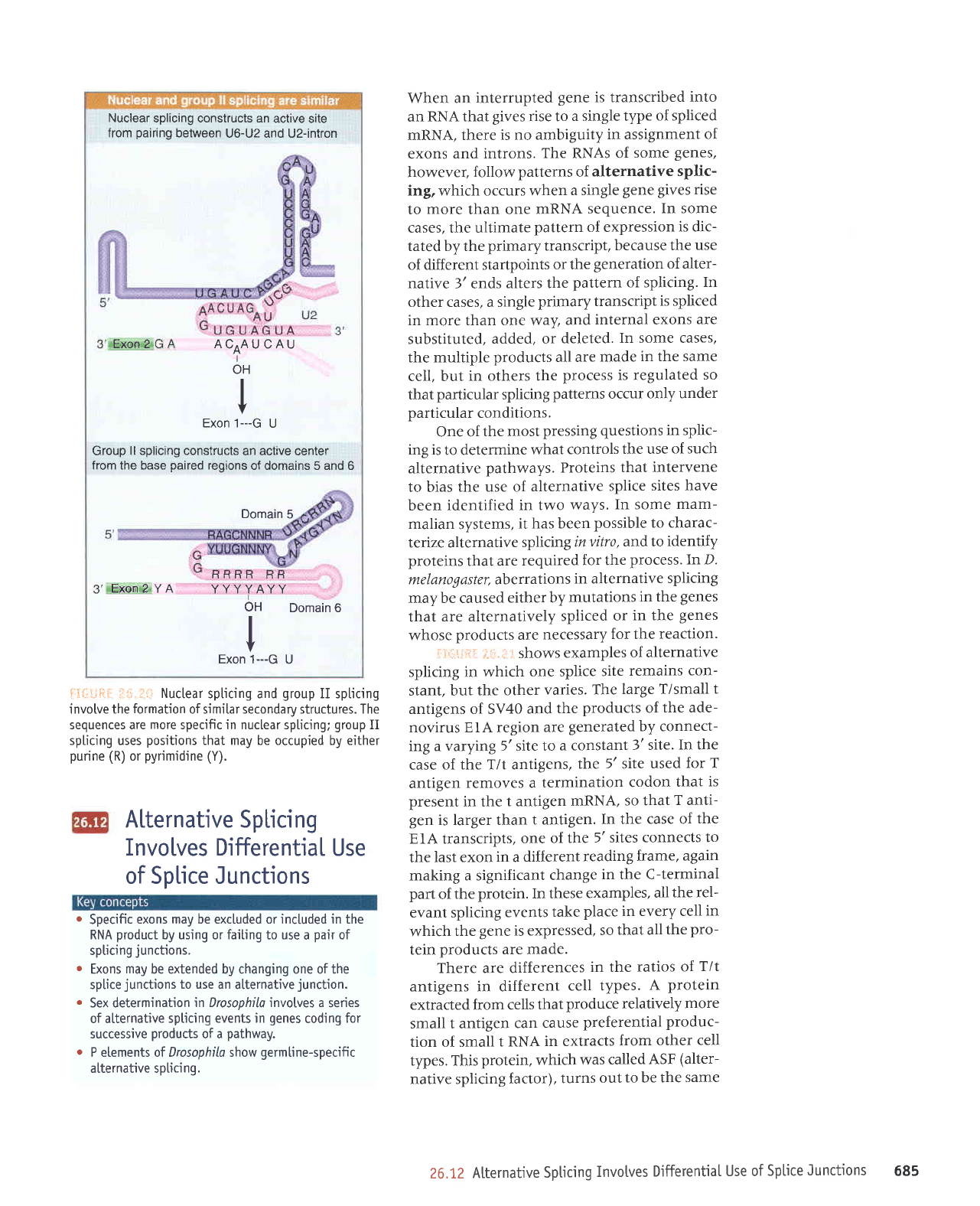
Nuclear
splicing constructs an
active site
from
pairing
between
U6-U2 and U2-intron
3'Exon2GA ACAAUCAU
OH
I
I
v
Exon 1---G
U
Group
ll splicing constructs
an active center
from the base
paired
regrons
of domains 5 and 6
Domain
5
nnnn nn
3'
Exon2 YA
YYYYAYY
OH
Domain 6
I
I
v
Exon 1--G
U
i:lil:..i+ir
ii:..ii:
Nuclear
spticing and
group
II spticing
invotve the
formation
of similar secondary structures. The
sequences are
more
specific in nuclear spl.icing;
group
II
spticing uses
positions
that may be occupied by either
purine
(R)
or
pyrimidine
(Y).
When an interrupted
gene
is transcribed
into
an
RNA that
gives
rise to
a single type
of spliced
mRNA, there
is no ambiguity
in assignment
of
exons
and introns.
The RNAs of
some
genes,
however,
follow
patterns
of
alternative
splic-
ing, which occurs when
a single
gene
gives
rise
to
more
than one
mRNA
sequence.
In some
cases, the ultimate
pattern
of expression
is dic-
tated by the
primary transcript,
because the
use
of different startpoints
or the
generation
of alter-
native
3'ends
alters the
pattern
of splicing.
In
other cases, a single
primary transcript
is spliced
in more than one way,
and
internal exons
are
substituted.
added, or
deleted.
In some cases,
the multiple
products
all are
made
in the same
cell, but
in others the
process
is regulated
so
that
particular
splicing
pattems
occur
only under
particular
conditions.
One of
the most
pressing
questions in splic-
ing is
to determine
what
controls
the use
of such
alternative
pathways. Proteins
that intervene
to bias
the use of
alternative
splice
sites have
been identified
in two
ways. In some
mam-
malian
systems,
it
has been
possible to charac-
terize alternative
splicing
invitro,
and to
identify
proteins
that are
required
for the
process. In D.
melanogaster, aberrations
in alternative
splicing
may be caused
either by
mutations
in the
genes
that
are alternatively
spliced
or
in the
genes
whose
products
are
necessary
for the
reaction.
irit,i,i{;;r
:ri.:.i l shows
examples
of alternative
splicing in which
one splice
site
remains
con-
stant, but
the other
varies. The
large T/small
t
antigens of SV40
and
the
products
of
the ade-
novirus EIA region
are
generated by connect-
ing a
varying 5' site to
a constant
3' site.
In the
case
of the T/t antigens,
the
5'
site
used
for T
antigen
removes a
termination
codon
that
is
present
in the
t antigen
mRNA,
so that
T anti-
gen
is larger than
t antigen.
In the
case of
the
EIA transcripts,
one of
the
5' sites connects
to
the
last exon
in
a
different
reading
frame,
again
making a significant
change
in the C-terminal
part
of
the
protein. In these
examples,
all
the rel-
evant splicing
events
take
place
in
every cell
in
which
the
gene is expressed,
so
that all
the
pro-
tein
products
are made.
There are differences
in the
ratios of
T/t
antigens in different
cell types.
A
protein
extracted from cells
that
produce
relatively
more
small t antigen
can
cause
preferential
produc-
tion of small
t RNA
in extracts
from
other
cell
types. This
protein,
which
was
called
ASF
(alter-
native splicing
factor),
turns
out
to be the
same
DifferentiaL
Use
Junctions
Alternative Spl'icing
Involves
of Sp[ice
.
Specific
exons may be excluded or inctuded in the
RNA
product
by using or faiting to use
a
pair
of
spticing
junctions.
r
Exons
may
be extended by changing one of the
splice
junctions
to use
an alternative
junction.
.
Sex determination
in Drosonhilo invotves a
series
of atternative
spLicing events in
genes
coding
for
successive
products
of a
pathway.
r
P etements of Drosophila show
germtine-specific
atternative splicing.
26.12
ALternative
Splicing
Invotves
Differential
Use of
Splice
Junctions
685
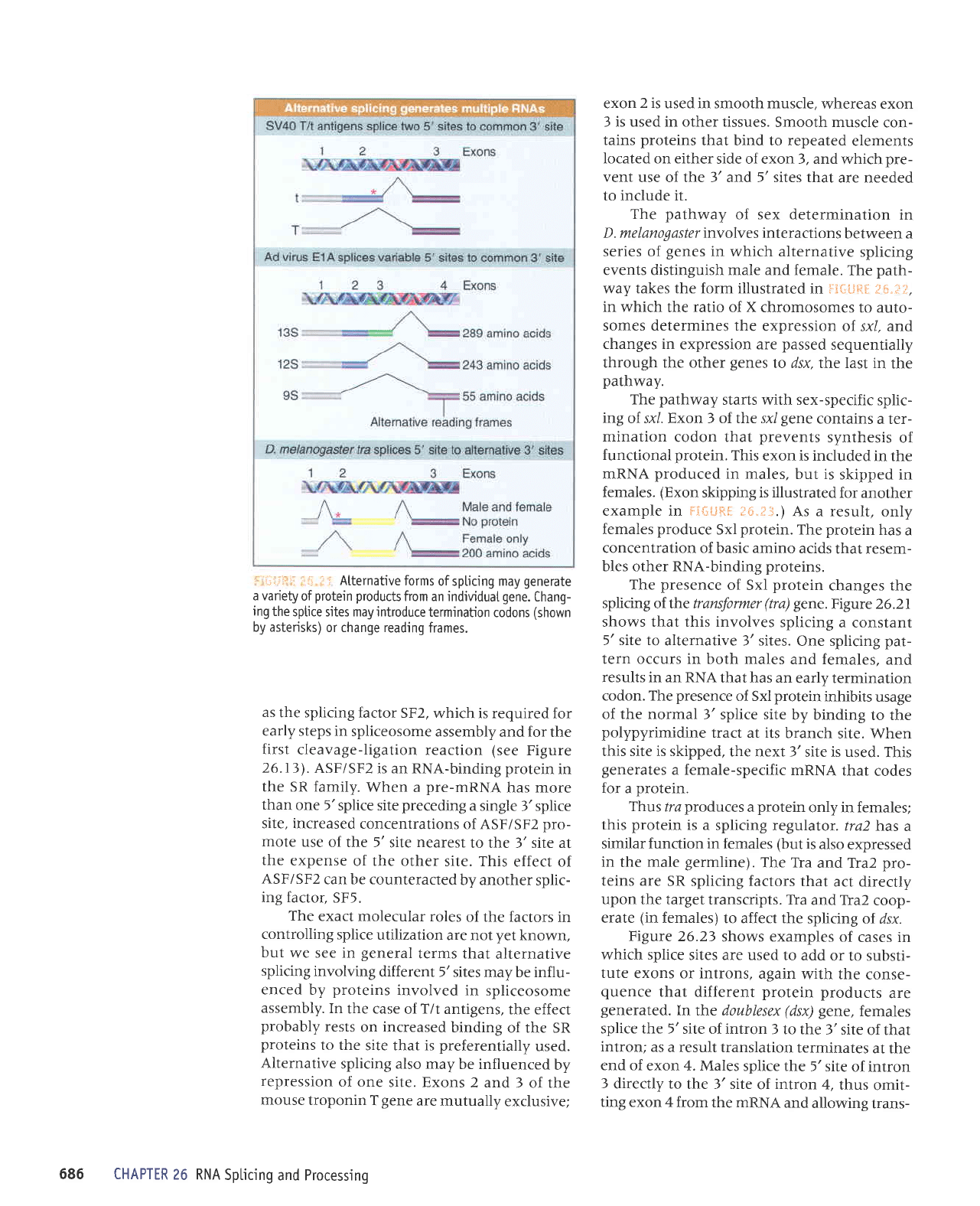
,
';-:r:!:
: i: . ; Atternative
forms
of spticing may
generate
a variety
of
protein products
from an individuat
gene.
Chang-
ing
the
sptice sites may introduce
termination
codons
(shown
by asterisks)
or change reading
frames.
as
the splicing factor
SF2,
which is required for
early steps in
spliceosome
assembly
and
for
the
first
cleavage-ligation
reaction
(see
Figure
26.13).
ASF/SF2
is an RNA-binding prorein
in
the SR family.
When
a
pre-mRNA
has more
than
one 5'splice
site
preceding
a
single 3'splice
site, increased
concentrations
of ASF/SF2
pro-
mote
use
of the 5'site nearest
to the 3'site at
the
expense
of the other
site. This
effect of
ASF/SF2
can be counteracted
by another
splic-
ing factor,
SF5.
The
exact molecular
roles
of the factors
in
controlling
splice
utilization
are not
yet
known,
but
we see in
general
terms that
alternative
splicing
involving
different
5'sites
may be influ-
enced
by
proteins
involved
in spliceosome
assembly.
In
the case
of
T/t
antigens,
the effect
probably
rests
on
increased
binding
of the SR
proteins
to the
site that is
preferentially
used.
Alternative
splicing also
may be influenced
by
repression
of one
site. Exons
2 and
3 of the
mouse
troponin
T
gene
are mutually
exclusive;
exon
2 is
used in smooth muscle,
whereas exon
3 is used in other tissues.
Smooth muscle
con-
tains
proteins
that bind to repeated
elements
Iocated on either
side of exon 3, and
which
pre-
vent
use of the 3'and 5'sites that
are needed
to include it.
The
pathway
of sex determination
in
D. melanogasler involves interactions
between a
series of
genes
in which alternative
splicing
events distinguish male and female.
The
path-
way takes the form illustrated
in F3*l"i$til
3*.If,
in which
the
ratio
of X chromosomes
to auto-
somes determines the
expression
of sxl, and
changes in
expression are
passed
sequentially
through the other
genes
to dsx, tll'e last in
the
pathway.
The
pathway
starts with sex-specific
splic-
ing
of sxl. Exon 3 of the sxl
gene
contains
a ter-
mination
codon that
prevents
synthesis
of
functional
protein.
This
exon is included
in the
mRNA
produced
in
males, but is
skipped in
females.
(Exon
skipping is illustrated
for another
example in FIfi$R{ ;S.:ri.)
As a result,
only
females
produce
Sxl
protein.
The
protein
has
a
concentration of basic amino
acids
that resem-
bles other RNA-binding
proteins.
The
presence
of Sxl
protein
changes the
splicing
of lhe transformer
(tra)
gene.
Figure 26.21
shows that this involves
splicing
a constant
5' site to
alternative J' sites.
One splicing
pat-
tern occurs in both males
and females,
and
results in an RNA
that has an
early termination
codon. The
presence
of Sxl
protein
inhibits
usage
of the normal
3' splice site
by binding
to the
polypyrimidine
tract at its
branch
site.
When
this site is skipped,
the next 3'site
is used.
This
generates
a female-specific
mRNA
that
codes
for a
protein.
Thus
/ra
produces
a
protein
only in females;
this
protein
is a
splicing regulator.
tra2 has
a
similar function in
females
(but
is
also
expressed
in
the male
germline).
The TIa
and Tra2
pro-
teins are
SR splicing factors
that
act directly
upon the target
transcripts. TIa
and TIa2
coop-
erate
(in
females)
to affect the
splicing
of dsx.
Figure
26.23
shows examples
of
cases in
which splice
sites are used
to add
or to substi-
tute
exons or introns,
again
with the
conse-
quence
that
different
protein
products
are
generated.
In the doublesex
(dsx)
gene,
females
splice the 5'
site of intron
3 to the
3'site
of that
intron;
as
a
result
translation
terminates
at the
end of
exon 4. Males
splice the
5'site
of intron
3
directly to
the 3'site
of
intron
4,
thus
omit-
ting exon
4 from the mRNA
and
allowing
trans-
686
CHAPTER
26 RNA
SpLicing
and Processing
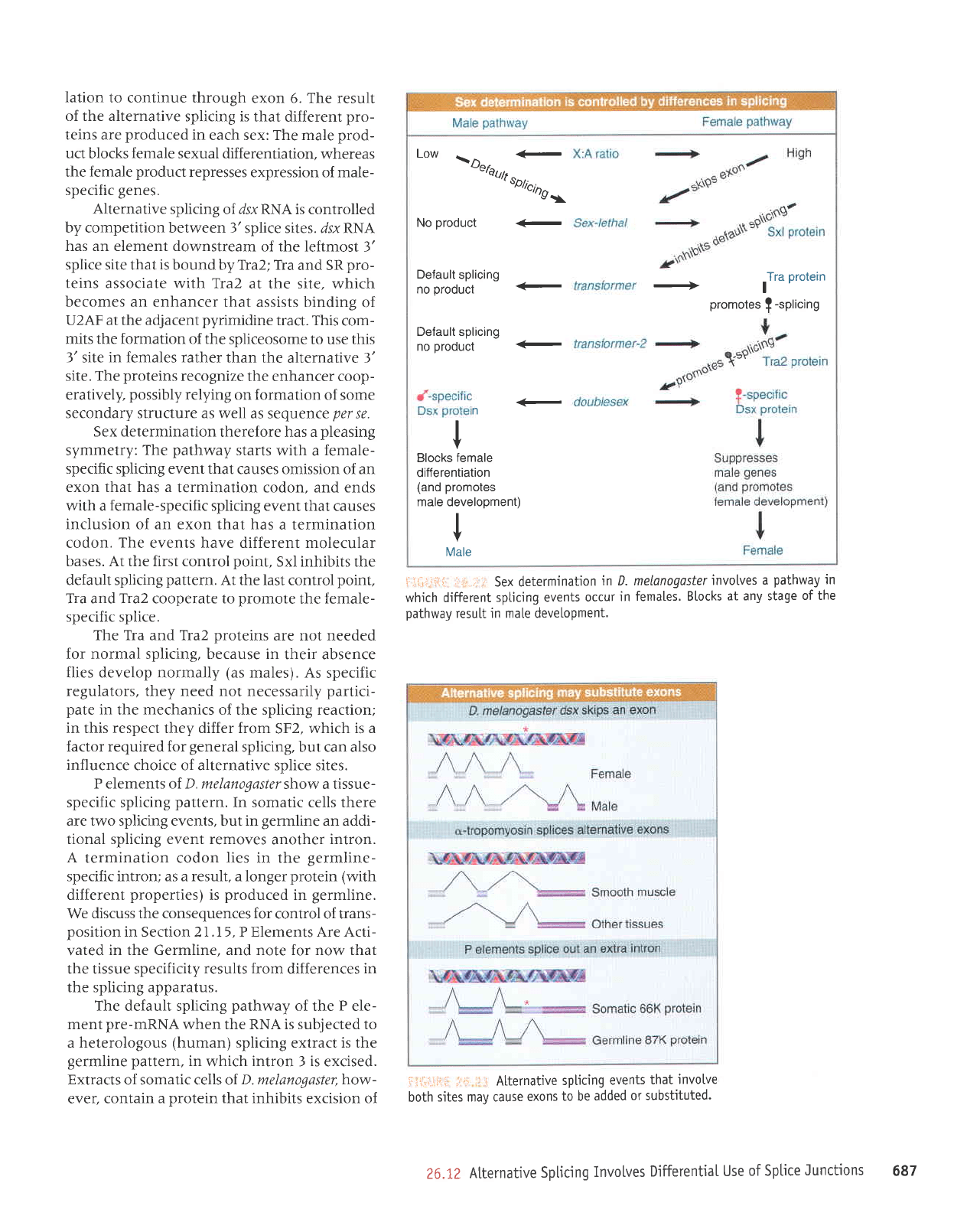
lation
to continue through
exon 6. The result
of the alternative
splicing is
that different
pro-
teins are
produced
in
each sex: The male
prod-
uct blocks
female
sexual differentiation,
whereas
the
female
product
represses
expression of male-
specific
genes.
Alternative splicing
of dsx RNA is controlled
by competition between 3'
splice sites. /sx RNA
has an element downstream
of the leftmost
3'
splice site that
is
bound by Tra2; Tfa
and SR
pro-
teins associate with Tra2
at the site, which
becomes an enhancer
that assists binding
of
U2AF at the adjacent
pyrimidine
tract. This
com-
mits the formation of the
spliceosome to use this
3'
site
in females
rather than the
alternative 3'
site. The
proteins
recognize
the enhancer coop-
eratively,
possibly
relying on formation
of some
secondary structure as well
as sequence
per
se.
Sex determination
therefore has a
pleasing
symmetry:
The
pathway
starts
with a
female-
specific splicing event that
causes omission of an
exon that has a
termination codon, and ends
with a
female-specific
splicing event
that causes
inclusion of an exon that has
a termination
codon.
The
events have different molecurar
bases. At the first control
point,
Sxl inhibits the
default splicing
pattern.
At the last
control
point.
Tta and Tra2 cooperate to
promote
the
female-
specific splice.
The Tra and Tra2
proteins
are not needed
for normal splicing, because in
their absence
flies develop normally
(as
males). As
specific
regulators, they need not
necessarily
partici-
pate
in
the
mechanics
of the splicing reaction;
in this respect they differ from
SF2,
which is a
factor required for
general
splicing, but can also
influence
choice of alternative splice sites.
P elements of D. melanogaster
show a tissue-
specific splicing
pattern.
In somatic cells there
are two splicing events, but in
germline
an addi-
tional splicing event removes
another
intron.
A
termination codon lies in the
germline-
specific intron; as a result, a longer
protein (with
different
properties)
is
produced
in
germline.
We discuss the consequences for
control of trans-
position
in Section 2l .I5
,
P Elements Are Acti-
vated
in the Germline, and note for now that
the tissue specificity
results
from differences
in
the splicing appa ratus.
The default splicing
pathway
of the P ele-
ment
pre-mRNA
when the RNA is subjected to
a heterologous
(human)
splicing extract is the
germline pattern,
in
which
intron
3
is
excised.
Extracts of somatic cells of
D.
melanogaster,how-
ever, contain
a
protein
that inhibits
excision
of
{:lili:iiil
;i,:].::;.:'
Sex determination
in D. melonogoster
invotves
a
pathway
in
which different
spticing events
occur
in
females. Btocks
at any stage
of the
pathway
resu[t in ma[e development.
::ii.''i.iitir
":+
,i t
Alternative
splicing
events
that
involve
both
sites may cause
exons
to be
added
or substituted.
Low
\6
<-
"ehun
^
.o0/tcinn
v\
No
product
<-
Default
splicing
no
product
+
Default splicing
no
product
-
n
-
I
V
Blocks
female
differentiation
(and
promotes
male development)
I
V
Male
Tra
protein
+
I
promotes
t
-splicing
26.L2
Alternative
Spticing
Invotves
DifferentiaI
Use
of Sptice
Junctions
687
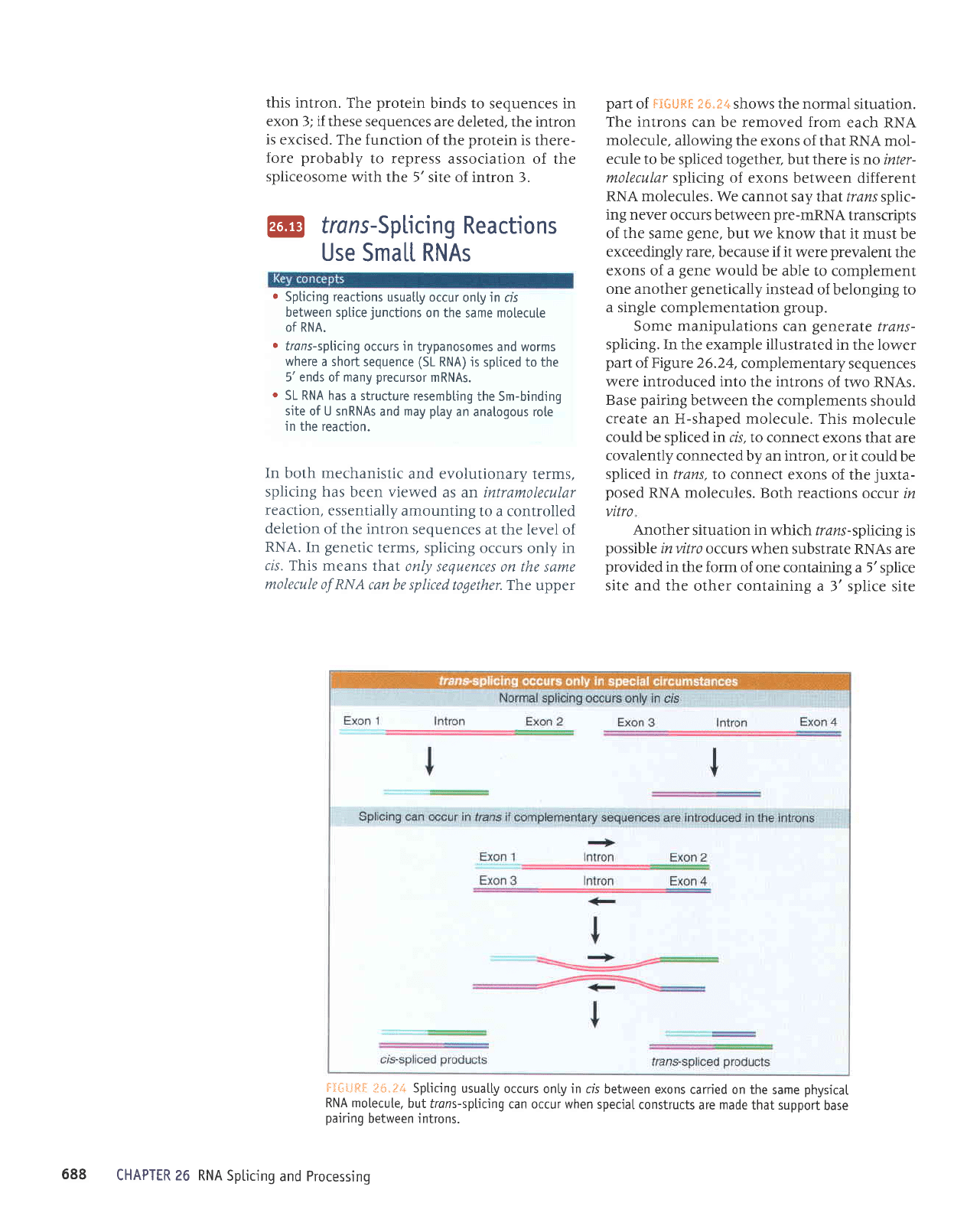
this intron.
The
protein
binds to sequences in
exon
3; if these sequences
are deleted, the intron
is
excised. The function
of the
protein
is
there-
fore probably
to repress
association of the
spliceosome
with the 5'site
of intron 3.
@
frans-Splicing
Reactions
Use
Small. RNAs
.
Spticing reactions
usuatly occur
onty in crs
between splice
junctions
on the
same motecule
of RNA.
o
frons-splicing
occurs
in
trypanosomes
and worms
where
a short
sequence
(SL
RNA) is
spticed to the
5'ends
of
many
precursor
mRNAs.
o
SL RNA has
a structure resembting
the Sm-binding
site of U snRNAs
and
may
play
an
anatogous rote
in the reaction.
In both
mechanistic
and evolutionary
terms,
splicing has
been
viewed
as an intramolecular
reaction,
essentially
amounting
to a controlled
deletion
of the intron
sequences
at the level
of
RNA.
In
genetic
terms,
splicing occurs
only
in
cis. This means
that
only sequences
on the same
molecule
of RNA
can be spliced
together. The
upper
part
of
FISU*E
3s"t4 shows the normal
situation.
The introns
can be removed from
each RNA
molecule, allowing the exons
of that RNA mol-
ecule
to be spliced together, but there isno
inter-
molecular splicing of exons
between different
RNA molecules. We
cannot say that trans
splic-
ing never
occurs between
pre-mRNA
transcripts
of the same
gene,
but we know
that it must be
exceedingly rare,
because
if
it were
prevalent
the
exons of a
gene
would
be
able to complement
one another
genetically
instead
of belonging to
a single
complementation
group.
Some manipulations can
generate
trans-
splicing. In the example illustrated
in the lower
part
of Figure 26.24,
complementary
sequences
were introduced into
the
introns
of
two RNAs.
Base
pairing
between the
complements
should
create an H-shaped molecule.
This molecule
could be
spliced
in
cli, to connect
exons that are
covalently
connected by an intron,
or it could
be
spliced
in
trans, to connect
exons of
the
juxta-
posed
RNA molecules.
Both reactions
occur ir
vitro
Another
situation
in
which trans-splicingis
possible
invitro
occurs when substrate
RNAs are
provided
in the form of
one containing a 5'splice
site and the
other containing
a 3' splice site
fllStJfts
fr*.f*i. Spticing
usuatly
occurs onty in os
between exons
carried on the
same
physical.
RNA molecute.
but
frons-spticing
can occur when
speciaI
constructs
are
made
that support
base
pairing
between introns.
CHAPTER 26 RNA
Spticing
and Processing
688
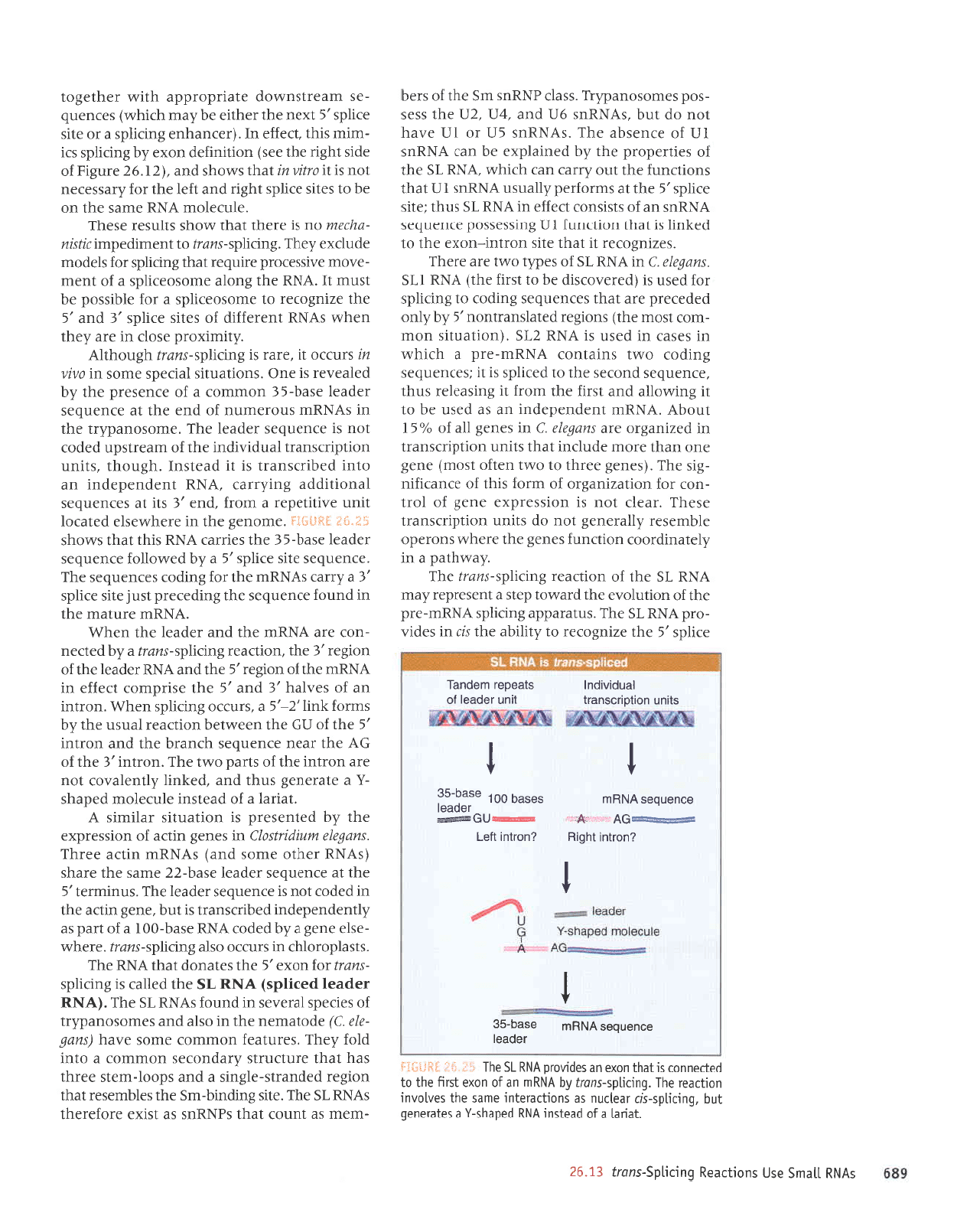
SVNU
lleus
asn
suor]lpeu
6uLr4d5-suo.r7
91.97
']PuPl
P
Jo
pPalsur y1r1x padeqs-1
e
saleteuaE
lnq
'6urrrlds-so
leellnu
se suorllplelur
auips
eql sellonur
uorllpar
aq1
'6uoqds-suo.r7
fq
ypXu
up
Jo
uoxa
leH
eql ol
pallauu0t
sr
lpql
uoxo
up sopr 0ld
vNU 1s
aql
1;
i:
"ij
l
..iEiI:ili-1
ropeol
ecuenbesylgtu
oseq-ge
+
I
I
+
I
;uo:1ur
1q0lg
auorlut
llel
@!eV:r-;r:r.r-tfir @ng@
ecuenbes
ylg.u
soseq
oot
"#f-"r?
+f
tl
tl
slrun
uorloucsuell
ltun
lopeal
lo
lenpr^lpul
sleoooJ ulopuel
aJrlds
,E
Jqt ezruSo)JJ
ot ^trlrqe
aql
st, ur sJpr^
-ord
VNU
fS
aql
'snteredde
3uo11ds
y51gru-ard
Jql
Jo
uounlole
eqt
pJemot
dals e
tuJSJrdJJ
^eru
VNU'IS
Jql
Jo
uorpeal
SurJrlds-sua4 JqI
'AeMqlPo
e uI
Llaleuproor
uortJunJ
sauaS aql eJeqM suoredo
JIqurJsJJ .{leraua8
lou
op
slrun
uorldrJJsueJl
JSaqJ
'JeJI)
lou
sr uorssardxe
JuJB
Jo
Iorl
-uoJ
JoJ
uorlezrue8ro
Jo
trrJoJ srql
Jo
JJuef,rJru
-3rs
aq;'(saua8
JeJql ot oMl uJlJo
lsoru)
auaS
3uo
upql eJoru apnlJul
leql
slrun uorldrJJsueJl
ut
pazrueSro
erc suoQap'3 ur
saua8
fie lo
"/oSI
lnoqv
'VNUru
tuapuadapur
up sp
pJSn
Jq ol
tI
SurMolle
pue
tsrrJ
Jql
uoJJ
1r
Sursealar
snql
'aruanbas
puoJJS
aql
ot
parrlds
sr
1r
lsaluanbas
Surpor
omt surpluoJ
VNUu-ard
e
qrrq,ra
ur sJSeJ
ur
pesn
sl
vNU ZfS
'(uorlpntrs
uour
-uroJ
lsour
aqt)
suorSJJ
pelplsueJtuou
,g
.{q.{po
paparard
aJe
teql
sJf,uenbes Surpor ol Sunuds
roJ
pesn
sr
(parazrorsrp
Jq ot
tsrrJ
rqt)
VNU
I:IS
'suaEap
',
uI
VNU 15
1o
sad,{1 o.,rort rre rrJql
'sazruSolar
1l leql
Jlrs uorlur-uoxJ aql ol
pa{ull
sI
leql
uortJunJ
1n
Surssassod aruanbas
VNUUS
ue
Jo
slsrsuoJ
TJJIJJ
ul
VNU'IS
snql
lJtrs
arrlds,s Jqt
le
suJoJradLlensn
VNuus
In
leql
suortJunJ Jql
lno.{.r.rer
uer
q)lqu
'vNU'IS
eql
yo
sarlrado,rd
aql dq
paureldxa
eq uer
VNUUs
In
Jo
rruasqP
rqJ
'svNuus
En
ro
In
r^Eq
lou
op
lnq
'svNuus
gn
pue
'vn'(.n
aql sses
-sod
sJruosouedLrl'sselJ
dNUus
rus eqt
Jo
sJJq
-rueur
se
tunoJ leql
sdNuus sp
lsrxJ
JJOJJJaT{1
svNg'IS aqJ'atrs Surpurq-rug Jqt
srlqruJsJJ
teqt
uorBJJ
papuerls-a18urs
e
pue
sdool-ruals aarql
seq
1eql
aJnlJnJls
.{repuoras uoruuroJ e
olur
ploy
.{aq1
'sJJnleeJ
uoruruoJ autos ateq
(sua6
-ap
))
apoleuau
eqt ut os1e
pup
seuosoued.drl
yo
sanads
lerelas
ut
punoJ
sVNU
TS
eqJ'(VNU
rappal
parllds)
VNU
TS
ar{t
prllel
sr Sunuds
-sua4
rol uoxJ
,s
eql saleuop
leql
vNu
eqJ,
'stseldorolqr
ul srnJJo
osp Suoqds-sua;4'el:.qlv'
-as1a
aua8 e
Lq
papor
VNU
rseq-ggI
p
Jo
ued
se
.dpuapuadapur
paqrrJsueJl
sr
lnq'aua8
urpe aql
ur
papoJ
lou
sr aruanbJs
Jepeal aqJ'snuruJJl
,s
Jqt
le
JJuJnbas rapeal eseq-Zz Jrues Jr{l eJpqs
(sV5U
Jeqto eruos
pue)
syggru urlJp earqJ
'suvCap
wntpulsll) ur
saua8 urlf,e
Jo
uorssardxa
aqt Lq
paluasard
sI uollentls
JplIruIS
V
'terJel
e
Jo
ppJlsur
JInJJIour
padeqs
-,1
e eleJauaS snqr
pue
'pJ{u{
,{pua1e^lor
1ou
aJe
uoJtur aql
1o
sged oul ae1,'uoJtur,€
eql
Jo
gV
eql rBau aluanbJs
qJupJq
eql
pup
uoJlul
,E
Jql
Jo
nD
Jql uaaMlaq
uoll)eJr
pnsn
aqt.{q
sruJoJ
>luq
,e-,s
e
'sJnJJo
Sunuds
uJqAA
'uorlur
ue
Jo
sa^Ieq
,€
pue,5
Jql asrrdruot
lJeJJe
ur
vNuru
aqr;o uor8ar,E
rql
pue
VNU
repeal eql
Jo
uorSar,€
rql
'uoplear
Suoqds-sua4e
trqpapau
-uo)
are
vNuru
aql
pue
rJpPel eql uaqM
'YNUtu
eJnleru Jql
ut
punol
aruanbas aql Surparard
lsnI
a]rs aruds
,€
E
[uet svNUtu eql Jo] Sutpor
saruanbas aq1
'aruanbas
alrs
arqds
,S
e
(qpemolloJ
aruanbas
JJpeJI
eseq-E€ eql seuJeJ
vNu
slql
leql
sMoqs
git.'*B
*El1*gj
'aruouaS
aq1 ur JJJqMeslJ
pelerol
lrun
anrlrladal e ruorJ
'puJ
,€
s1r
le
saruanbas
I€uortrppp
Surz(rrer
'vNU
tuJpuadaput
ue
otur
pJqrJJsuprt
sr
U
peelsul
'q8noql 's1run
uortdrnsuert
1enprllput
aql
Jo
rupallsdn
papor
tou
sr JJuenbas
rapeal JqJ
'eluosoued.drt
aqt
ur
sVNUru snoJJurnu
Jo
puJ
aql
le
a;uanbas
rapeel JSeq-S€ uoruuroJ
e
Jo
eJuJseJd aqt
,{q
palealJr
sr euo
'suollenlls
ptrads
aluos uI o4l4
ur sJnf,)o
tl
'JJeJ
sr Sutrtlds-szu4
q8noqtly
'Ltruuord
esolJ ur are,{aqt
uJr{,lt sVNU
turreJJrp
Jo
sJ}ts arqds
,E
pup
,S
aql azruSorar
01 Jruosoeruds
e rol alqtssod aq
tsnur
U'VNU
Jqt 3uo1e aruosoarqds
e
Jo
luJru
-elour
a,rrssarord
armbar
leqt
Sunrlds JoJ slapou
epnlJxe,{.aq1'Suorlds-suzll
o1
luarutpadur
)tistu
-o4)alu
ou sr eJeql
leq]
Moqs sllnseJ asaqJ
'alnJelolu
YNU
elues eql uo
eq 01 satrs ar11ds
tq8r.r
pup
Uel
eql
roJ,{.ressarau
10u
sr
11
0111^
u|]eql sMoqs
pue
'
(zI'
9e
arnSrg
;o
aprs
lq8rr
Jql Jas)
uorlrurJep uoxa
dq Suntlds srt
-rurur
srql
'DaJJJ
u1
'(raruequa
3utt11ds e Jo etIS
arrlds
,g
lxJu
eqt
JJqlta aq.deru
qJIqM)
saruanb
-es
urpJJtsuruop alerrdordde
qlpu
raqtaSot
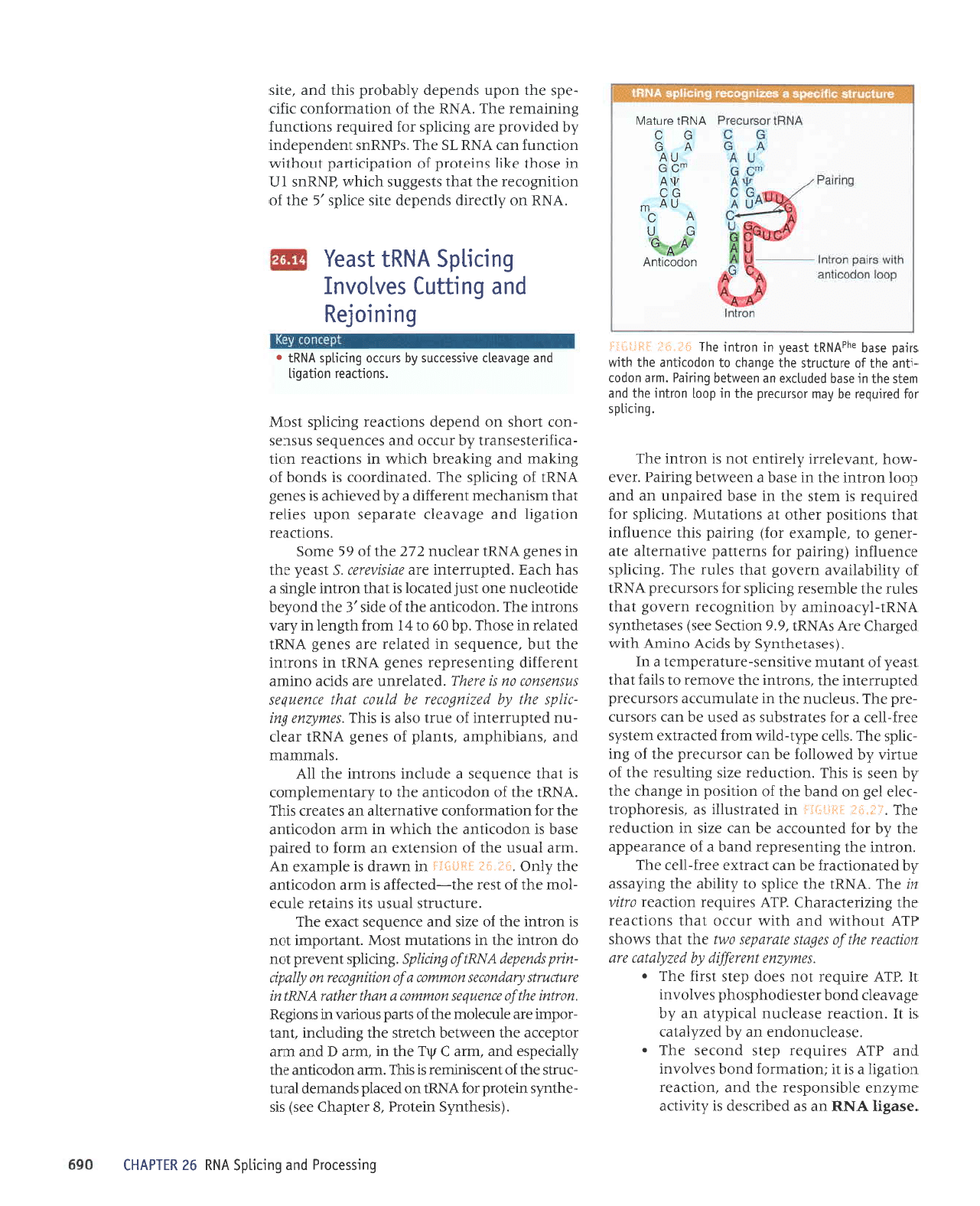
'ase8l[
VNU
ue se
pJqrJ]sJp
sr
^tr^rlJe
au^zue alqrsuodser Jqt
pue
'uortJeaJ
uorlPSrl e sr
lr
:uorleurro} puoq
senlo^ur
puP
dJV
saJrnbal
dals
puoras
er{f
o
'JSPJIJnuopuJ
ue
^q
pJZ^[PlPJ
sI
1I
'uoll)eJJ
aseapnu
Ierrd^le
ue ^q
eBeAeJIJ
puoq
ratserpoqdsoqd
saAIoAur
tI
aJV
arrnbJJ
tou
srop dats
lsl;
e{I .
'saw[zua
Tuatallry
[q
paz[1o1at
aw
ulq)oal ary
t0
sa6a$ aqndas 0il1
eiqt
teqt
sMoqs
dJV
lnoqlrM
pue qlrM
JnJJo
leql
suortreJr
aql Surzrralrereq)
41y
sarrnba J uort)eJr lJltl
u! ILII'VNUI aqt
ar11ds ol Llrlqe
aql Sudesse
Lq
pareuotrlprJ
eq ueJ
tJertxJ
JJJJ-lleJ eqJ
'uoJtul
Jql Surlueserdar
pueq
e
;o
aruereadde
aqt Lq roJ
paluno)Je
Jq UPJ
azIS uI uollf,npJJ
JIIJ
'iJ"lll
rts"l'jlj5j
uI
pJlellsnll
se
'srsaroqdorl
-ra1a
1a3
uo
pupq
Jql
Jo
uortrsod ur a8ueqr
aql
,{.q uaas sl slqJ
'uorlJnpeJ
azrs 3ur11nsal
eql
Jo
enlJIA
zlq
pezrto110l
eq ueJ
ros:nra,rd aql
;o
3ur
-ruds
aq1
's1ar
ad.&-p1rM ruolJ
pJtJBrtxJ
uals.{s
aJJJ-llJ) e JOJ SelPrlsqns
Se
pasn
aq upJ sJosrnJ
-ard
aq1
'snJIJnu
Jql ur Jlelnunlre
sloslnla:d
paldnrratur
Jql
'suoJlur
eql JAoruaJ
ol slre;
leql
1sea.,(
1o
luelnur
alrlrsues-e-rnleradual
e u1
'(saselaqluLg,{q
spny ouruy
qtr.lr
pa8req3
JJV svNut
'6'6
uorDas aas)
saselaqtu.{s
VNdl-lzbeourue
.dq uorltuSorar
ura,r.o8
leql
selnJ Jql elqruJSeJ
Suuds roJ
sJosJn)aJd
VXU1
;o
Llrlrqelene
u:ano8
teqt
sJInJ aq;
'Sungds
JJuJnlJur
(Surrred
ro; suratled
alrteuJJtle Jtp
-raua8
ol
'aldruexa
roy)
Surrred srqt JJuanlJur
leql
suollrsod raqto
te
suortetnw
'3uor1ds
ro1
parrnbar
sr ruJls
aql ur aseq
paledun
ue
pue
dool uorrut
aql ur JSpq
e ueeMlJq Surrre4
'rana
-Moq
'luplJlarrr
,{.larrlua
lou
sr uoJlur aqJ
.6
u L:rt ds
ro1
parLnbar
aq feu rosrnrard
aq1 ur
dool uorlur oql
pup
uals oql uI aspq
papnl]xo
up uoaMlaq
6uure6
'Lure
uopot
-rlue
aql
Jo
alnlrnrls
aq1 abueqr ol uopolrlup
oql
qllM
srted eseq.qaVNUl
lseeA
ur uollur aq1
iif"tlr.l ;!ijft1]j":i
6uLssaror6
pup
6unttds
VNU
9Z
UlIdVHl
'(slsaqrur(5
urJlord
'g
ratdeq) aas) sts
-aqtuls
urelord:o;
y1rJg1
uo
pareld
spueruJp
Iernl
-Jrus
ar{1
Jo
lueJsrurureJ
sr sr-qJ
'rrue
uopoJrlre Jql
.dleoadsa
pue
'rure
)
AJ
Jql ur
'urJe
(
pup
rxJe
rotdane eql uJeMleq
qrteJts
aqt
Surpnpur
'1ue1
-rodrrn
are alnrelou Jql
Jo
supd snouel rn suo6ag
'uo4ut
at11lo nuanbas uownao D uaLliJaLlpJVNA|u!
an1n4s
,Oapunas u7utLuo a
to
uotltuqont uo fladn
-uttd
spuadap
VNallo
6unud5
'Suortds
tua,rard tou
op uoJtur aqt
q
suopelnu
lsow'lueuodlur
]ou
sr uollur Jql
Jo
JZrs
pue
a:uanbas
DexJ
JqI
'eJnlJnJls
Iensn
slr surPleJ aln)a
-loru
Jql
Jo
lsJJ
Jql-pJllJJJe
sr ruJe uopoJllue
aqt
^luo
'ii;"f
f :lijiilli:{
uI
umpJp st aldruexa uy
'ruJe
Ipnsn
aqt
Jo
uorsuelxe up uJoJ ol
parred
JSeq sr uopoJrlue eql
q)rq^\
ur ruJe uopoJrluP
aql JoJ uorleuroJuoJ J^rleuJelle uP selEeJ) srqJ
'VNut
aql
Jo
uopo)Ilue
eql ot ^,{;eluarualduror
sr
tpqt
aruanbas e Jpnpur
suortur Jqt
IIv
'sleurrueru
pue
'suprqrqdrue 'stueld
;o
saua8
vNut
rpalJ
-nu
paldnrretul
Jo
Jnrt osle sI slqJ
'saw[zua
6ut
-c4ds
a4l
fq
pazu1onl
aq
plnn
iaqt
atuanbas
snsuasun 0u st aJa4J'palelarun
aJe sprJP ourrue
tuaJJJJrp
Surluasardar saua8
VNU1
ul
suoJtur
Jqt
lnq
'aruanbas
ur
palplar
are saua8
yggt
patelJJ
ur JSoqJ
'dq
99
ol
?I
ruorJ
qr8ual
ur ^,i.ren
suortur
aqJ
'uopoJltue
rql
Jo
Jpls,€ aql
puo,{aq
epuoelJnu auo
lsnfpale]ol
sr
lpql
uoJlur a13urs
e
seq
qJef
'patdnrratur
JJe aDSt^aJn'5
1sea.{.
aql
ur saua8
vNUl
rerpnu
ZLT
rqr
Jo
6S
Jruos
'suorlJPeJ
uorle8rl
pue
a8erleap aleredas uodn sarlar
teql
usrueqf,Jur
tuJreJJrp
e.4.q
panaqre
sr saua8
VNUI
]o
Sunrlds eql
'petputproor
sI spuoq
Jo
Surleru
pue
3ur>1earq
qJIqM
ur suort)pJJ uorl
-PJrJrJalSeSuerl
,{q rnrro
pue
saruanbas snsuas
-uoJ
uoqs
uo
puadap
suorlJeeJ
SuDrlds
1so1r11
'suorllea.l
uotle6p
pue
abenealr olrssallns
r\q
srnrro 6uLrrtds
VNUI
o
6ururolag
pue
6u$lnl sa^lo^ul
6unqd5
VNU1
lsPa1
'vNu
uo
,(1Da-Irp
spuadap alrs arllds
,s
Jql
Jo
uorlruSorar
Jql
teqt
stsaSSns
qJIqM
ANUUs
In
ur asoql a41 suratord
1o
uorlednrlred
1noq1ru.
uorDunJ uer
YNU'IS
aqJ'sdNuus
luapuadapur
,{q
paprnord
are 3un11ds ,ro;
parrnbar
suortf,unJ
Surureruar JqJ'VNU Jqt
Jo
uortpuroJuof, f,rJrJ
-ads
aql uodn spuadap Llqeqord slql
pue
'etrs
uopocrluv
v"9
en
VC
NV
tU
JJ
AV
NV
VE
OC
vNU]
ernlen
